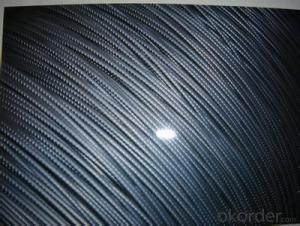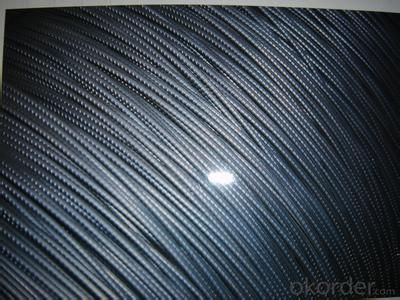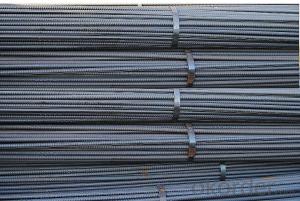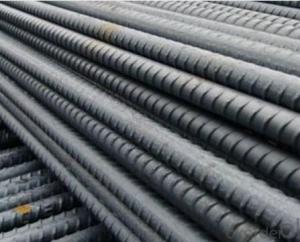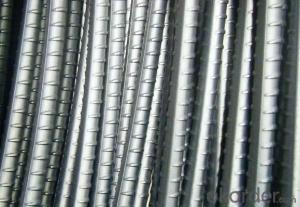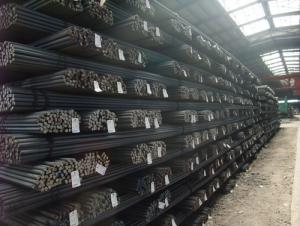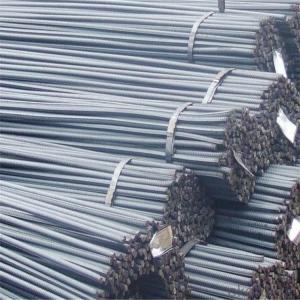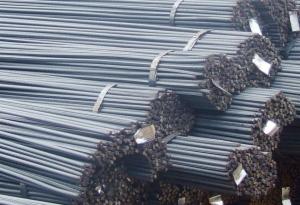Disk shaped hot rolled reinforced bar
- Loading Port:
- China Main Port
- Payment Terms:
- TT OR LC
- Min Order Qty:
- -
- Supply Capability:
- -
OKorder Service Pledge
OKorder Financial Service
You Might Also Like
Valvata is like as disc screw steel wire together, is also building steel. Hot rolling screwed the new standards are called HRB335, HRB400, HRB500,according to the intensity level (tensile strength yield point /) to the classification, behind the number is the intensity value, the unit is Mpa. H, R, B respectively (Hotrolled), hot rolled ribbed steel bar (Ribbed), (Bars) the threeword's first letter English. Finishing rolling rebar refers to the use of thread steel bar for prestressed concrete, which belongs to the rolled steel used in construction.
It and the ordinary wire bundling mode is the same, but the use of the requiredstraightening. The general market is 6.5-8.0-10-12-14 majority, are building steel.
The advantages of steel - steel disk disk
Screw thread steel is only 9-12, disk can demand random intercept.
Plate steel - disk model
Disk type generally have 6, 8, 10 and three than the thread and wire rodprices are high.
Hot rolled reinforced bar is through the finished steel hot rolling forming and cooling, from low carbon steel and ordinary alloy steel under the condition of high temperature and pressing, mainly used for reinforcement of reinforced concrete and prestressed concrete structure, is one of the varieties of steelused in the largest amount of civil engineering and architecture. Steel bar diameter 6.5 ~ 9 mm, most rolled into plate; the diameter of 10 ~ 40 mm is generally 6 ~ 12 meters long straight. Hot rolled reinforced bar should have a certain strength, i.e. the yield point and tensile strength, it is the main basis forstructure design. Divided into hot-rolled round steel and hot-rolled ribbed bartwo. Hot rolled reinforced bar for soft rigid, fracture occurs when the neckingphenomenon, larger elongation.
Use
Three screw steel HRB400 HRB335 two screw steel, screw thread steel is nowinside the buildings will be less, then the three screw steel and two screw steelis mainly used for what ah, in order to solution to the problem.
Two screw steel subway project more, three screw steel housing constructionprojects more. In addition, the original grade two steel is more, are now in thepromotion of the new grade three steel structure, concrete applications have become very popular. Three screw steel used more in the main reinforced beam column, two screw steel used more in the stirrups, recent governments have issued expressly eliminated high HRB335 two screw steel and HPB235.
So the next day, three screw steel will be applied widely, in addition the seismic(with E) thread steel will be widely applied in our daily life.
There are two commonly used classification method of screw thread steel: one is to shape classification, according to the different spacing section shape andrib rib classification or types, such as the British Standard (BS4449), thethread steel is divided into type I, type ii. Hold this classification of main reaction performance of screw thread steel. Two is the performance of classification (class), for example, China's current implementation of standards, steel as (G B1499.2-2007) wire for 1499.1-2008), according to the intensity level (tensile strength yield point /) will screw thread steel is divided into 3 levels; the Japanese industrial standard (JI SG3112), according to the comprehensive performance will screw thread steel divided into 5 categories;British Standard (BS4461), and also provides some level of performance testof screw thread steel. In addition to the screw thread steel can be classified according to purpose, such as reinforced concrete with ordinary reinforcedand prestressed reinforced concrete heat treatment steel etc..
"Fake hot rolled ribbed steel bar steel on the market (commonly known asthread steel) unqualified factors are mainly: 1, nominal size smaller than actualsize specifications about the actual weight, dealers through purchase,theoretical weight delivery to earn the amount of metal, profits. 2, the relatively low strength. 3, the chemical composition of the unqualified rate high. The main reason is the small rolling mill of substandard ingredients, mixing with soilbillet rolling screw steel caused by.
In the purchase of the screw thread steel, first of all from the outward appearance size, available cursor card measuring simple measurement of the actual size is better than showing the dimension (general screw steel are rolled with the specification marking) about a specification or more (such as Ø12 screw thread steel standard diameter was 11.5 + 0.4mm, and false and inferior rebar diameter are mostly about 10mm). At the same time, someinferior screw thread steel by rolling way to deceive the people vision, so from the end face of the reinforced observation for flat oval shape, and the formalend surface should be the basic circular; second, from the surface quality, and inferior screw steel because of the use of adobe rolling, the surface quality is poor, often with a surface defects, a whole rough sense. At the same time,some small rolling mill of the heating temperature, the rolling speed is not enough, the surface reddish color; third, regular steel in most largemanufacturers factory packing, bundles of steel are hung with metal sign realcorresponding, indicating manufacturers, steel grade, batch number,specifications and test code. And false and inferior steel due to poor production conditions, no large hoisting equipment, mostly small (ten or sobinding) package or in bulk, no metal signs, no guarantee of quality. Of course, to fundamentally avoid buy fake bar, or direct agents to buy name brand manufacturers, especially the province famous brand steel (for three steel "Min light" brand screw steel) has stable quality, and even if the dispute is also easy to handle. Experienced people can also distinguish other chemicalcomposition through spark.
- Q: How do steel rebars contribute to the durability of a structure?
- Steel rebars contribute to the durability of a structure by providing reinforcement and strength to concrete. They help to prevent cracking and structural failure by absorbing and distributing tensile forces, enhancing the overall structural integrity and resilience. Additionally, steel rebars offer resistance to corrosion, ensuring the longevity and durability of the structure.
- Q: Are steel rebars suitable for use in historical restoration projects?
- Steel rebars can be suitable for use in historical restoration projects, depending on the specific requirements and circumstances. Steel rebars offer several advantages, such as their high strength, durability, and ability to reinforce structures effectively. These qualities make them a popular choice in modern construction and renovation projects. However, when considering the use of steel rebars in historical restoration projects, it is crucial to take into account the preservation and authenticity of the original structure. Historical buildings often have unique architectural features and materials that should be respected and preserved. In some cases, the use of steel rebars may not be suitable, especially if it compromises the historical integrity or visual appearance of the structure. This is particularly relevant for buildings with significant historical value or those that are protected by heritage regulations. If steel rebars are deemed necessary for structural reinforcement in a historical restoration project, it is essential to ensure that they are discreetly integrated, minimizing their visual impact. This can be achieved by concealing them within the original materials or using techniques that replicate the appearance of the original construction. In summary, while steel rebars can offer structural benefits and durability, their use in historical restoration projects should be carefully evaluated to ensure that they align with the preservation goals and requirements of the specific project. Preservation of historical authenticity should always be a priority in such endeavors.
- Q: What is the minimum cover required for steel rebars in concrete structures?
- The minimum cover required for steel rebars in concrete structures typically depends on various factors such as the type of structure, environmental conditions, and design specifications. However, as a general guideline, the minimum cover for steel rebars in concrete structures is often recommended to be around 1.5 inches (38 mm) to provide adequate protection against corrosion and ensure structural integrity. It is essential to consult with structural engineers and refer to local building codes and standards for specific requirements.
- Q: Can steel rebars be used in the construction of office buildings?
- Indeed, office buildings can utilize steel rebars for construction purposes. When it comes to concrete structures, such as office buildings, steel rebars are frequently employed as reinforcements. By enhancing the concrete's resilience and rigidity, they contribute to its enhanced ability to withstand cracks and bending. Consequently, the incorporation of steel rebars guarantees the structural soundness of the building, particularly in regions subjected to substantial stress or load-bearing demands. Moreover, steel rebars boast durability and longevity, rendering them a dependable option for construction endeavors.
- Q: How do steel rebars affect the overall weight of a structure?
- Steel rebars increase the overall weight of a structure due to their high density and strength. Their inclusion in concrete or other building materials provides additional reinforcement, enhancing the structural integrity and load-bearing capacity but also adding to the weight of the structure.
- Q: How are steel rebars classified based on their yield strength?
- Steel rebars are classified based on their yield strength by assigning them grades or designations, such as Grade 40, Grade 60, or Grade 75. These grades indicate the minimum yield strength in thousands of pounds per square inch (ksi) that the rebars are able to withstand before permanent deformation occurs.
- Q: Are steel rebars suitable for use in sports stadiums and arenas?
- Yes, steel rebars are commonly used in sports stadiums and arenas due to their strength, durability, and ability to withstand heavy loads, making them suitable for such structures.
- Q: Can steel rebars be used in high-temperature environments?
- Yes, steel rebars can be used in high-temperature environments. Steel has a high melting point and retains its strength and durability even at elevated temperatures. However, it is important to consider the specific grade and composition of the steel rebar, as some types may have limitations in extremely high-temperature conditions. Additionally, the surrounding concrete structure should also be designed to accommodate the thermal expansion and contraction of the steel rebars.
- Q: How are steel rebars used in road and pavement construction?
- Steel rebars are used in road and pavement construction to provide reinforcement and enhance the structural integrity of the concrete. They are placed within the concrete mixture to withstand the tensile forces and prevent cracks or failures in the road or pavement, ensuring durability and longevity of the infrastructure.
- Q: Are steel rebars easy to handle and transport?
- Their relatively lightweight and compact nature makes steel rebars generally easy to handle and transport. Workers can easily lift the smaller sizes of rebars commonly used in construction without relying on heavy machinery. Moreover, the straight and elongated shape of rebars allows for convenient stacking and bundling, facilitating their storage and transportation. In addition, steel rebars can be easily cut and bent on-site using simple tools, contributing to their ease of handling during construction projects. However, it is crucial to consider that larger and heavier rebars may necessitate the use of special equipment or machinery to ensure safety and efficiency during handling and transportation.
Send your message to us
Disk shaped hot rolled reinforced bar
- Loading Port:
- China Main Port
- Payment Terms:
- TT OR LC
- Min Order Qty:
- -
- Supply Capability:
- -
OKorder Service Pledge
OKorder Financial Service
Similar products
Hot products
Hot Searches
Related keywords
